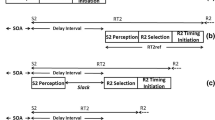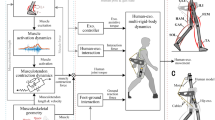Summary
The aim of this study has been to present firmer evidence that during stance functionally related postural muscles in the legs are activated according to fixed patterns. The importance of fixed patterns of activation for stabilization, balance, and movement control has received considerable theoretical and experimental attention. With regard to postural adjustment in humans, however, evidence for fixed activation patterns has been circumstantial only. Previous studies could not rule out the possibility that fixed patterns were caused by the mechanical coupling of rotatory movements among the joints of the body.
This study has shown that in subjects employing FSR adjustments during stance activation patterns among leg muscles at FSR latency (functional stretch response, 100–120 msec) are preprogrammed prior to a response and are, on the average, fixed, independent of the associated motions among the ankle, knee, and hip joints. The identical fixed patterns were produced by sway rotation about the ankle joints and by direct rotation of the ankles. A pattern was characterized as fixed when, during a 1 hr session, the ratios of estimated force between pairs of functionally related leg muscles remained constant. In addition, the sequence of activation among muscles was fixed and followed a course beginning at the ankle muscle and proceeding proximally.
The discussion of these results considered the functional implications of fixed contractile patterns during stance posture control.
Similar content being viewed by others
References
Arutyunyan, G.A., Gurfinkel, V.S., Mirskii, M.L.: Organization of movements on execution by man of an exact postural task. Biophysics 14, 1162–1167 (1969)
Bernstein, N.: Coordination and Regulation of Movements. New York: Pergamon Press 1967
Bousso, P., Ishai, G.: A study of myoelectric signals for arm prosthesis control. Bio-med. Engng. 10, 509–517 (1971)
Broder, M.R., Houtz, S.J.: Patterns of Muscular Activity in Selected Sports Skills. Springfield: C. C. Thomas 1967
Gottlieb, G.L., Agarwal, G.C.: Filtering of electromyographic signals. Amer. J. phys. Med. 49, 142–146 (1970)
Gelfand, I.M., Gurfinkel, V.S., Tsetlin, M.L., Shik, M.L.: Problems in the analysis of movements. In: Models of the Structural-Functional Organization of Certain Biological Systems (eds. V.S. Gurfinkel, S.V. Fomin, M.L. Tsetlin), pp. 330–345. London: MIT Press 1971
Grillner, S.: The role of muscle stiffness in meeting the changing postural and locomotor requirements for force developed by the ankle extensors. Acta physiol. scand. 86, 92–108 (1972)
Gurfinkel, V.S., Kots, Ya.M., Pal'tsev, Y.I., Feldman, A.G.: The compensation of respiratory disturbances of the erect posture of man as an example of the organization of interarticular interaction. In: Models of the Structural-Functional Organization of Certain Biological Systems (eds. V.S. Gurfinkel, S.V. Fomin, M.L. Tsetlin), pp. 382–395. London: MIT Press 1971
Gurfinkel, V.S., Lipshits, M.I., Popov, K.Y.: Is the stretch reflex the main mecha nism in the system of regulation of the vertical posture of man? Biophysics 19, 744–748 (1974)
Houtz, S.F., Fischer, F.J.: Function of leg muscles acting on foot as modified by body movements. J. appl. Physiol. 16, 597–605 (1961)
Houtz, S.J.: Influence of gravitational forces on function of lower extremity muscles. J. appl. Physiol. 19, 999–1004 (1964)
Joseph, J.: Man's Posture Electromyographic Studies. Springfield: C.C. Thomas 1960
Kots, Ya.M., Krinskiy, V.I., Naydin, V.L., Shik, M.L.: The control of movements of the joints and kinesthetic afferentation. In: Models of the Structural-Functional Organization of Certain Biological Systems (eds. V.S. Gurfinkel, S.V. Formin, M.L. Tsetlin), pp. 371–381. London: MIT Press 1971
Melvill-Jones, G., Watt, D.G.D.: Observations on the control of stepping and hopping movements in man. J. Physiol. (Lond.) 219, 709–727 (1971)
Nashner, L.M.: Adapting reflexes controlling the human posture. Exp. Brain Res. 26, 59–72 (1976)
Partridge, M.J., Walkers, C.E.: Participation of the abdominal muscles in various movements of the trunk in man. Phys. Ther. Rev. 39, 791–800 (1959)
Pew, R.W.: Levels of analysis in motor control. Brain Res. 71, 393–400 (1974)
Portnoy, H., Morin, F.: Electromyographic study of postural muscles in various positions and movements. Amer. J. Physiol. 186, 122–126 (1956)
Sherrington, C.S.: Flexion-reflex of the limb, crossed extension-reflex, and reflex stepping and standing. J. Physiol. (Lond.) 40, 28–121 (1910)
Welford, A.T.: On sequencing of action. Brain Res. 71, 381–392 (1974)
Vukobratovic, M., Stepanenko, Y.: On the stability of anthropomorphic systems. Math. Biosci. 15, 1–37 (1972)
Author information
Authors and Affiliations
Rights and permissions
About this article
Cite this article
Nashner, L.M. Fixed patterns of rapid postural responses among leg muscles during stance. Exp Brain Res 30, 13–24 (1977). https://doi.org/10.1007/BF00237855
Received:
Issue Date:
DOI: https://doi.org/10.1007/BF00237855




